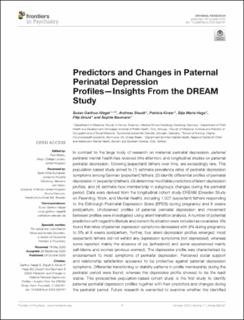Predictors and changes in paternal perinatal depression profiles — Insights from the DREAM study
Garthus-Niegel, Susan; Staudt, Andreas; Kinser, Patricia; Haga, Silje Marie; Drozd, Filip; Baumann, Sophie
Peer reviewed, Journal article
Published version
Permanent lenke
https://hdl.handle.net/11250/2728040Utgivelsesdato
2020Metadata
Vis full innførselSamlinger
- Artikler [5061]
- Publikasjoner fra CRIStin FHI [7536]
Sammendrag
In contrast to the large body of research on maternal perinatal depression, paternal perinatal mental health has received little attention; and longitudinal studies on paternal perinatal depression, following (expectant) fathers over time, are exceedingly rare. This population-based study aimed to (1) estimate prevalence rates of perinatal depression symptoms among German (expectant) fathers, (2) identify differential profiles of perinatal depression in (expectant) fathers, (3) determine modifiable predictors of latent depression profiles, and (4) estimate how membership in subgroups changes during the perinatal period. Data were derived from the longitudinal cohort study DREAM (Dresden Study on Parenting, Work, and Mental Health), including 1,027 (expectant) fathers responding to the Edinburgh Postnatal Depression Scale (EPDS) during pregnancy and 8 weeks postpartum. Unobserved profiles of paternal perinatal depression and movement between profiles were investigated using latent transition analysis. A number of potential predictors with regard to lifestyle and current life situationwere included as covariates. We found that rates of paternal depression symptoms decreased with 9% during pregnancy to 5% at 8 weeks postpartum. Further, four latent depression profiles emerged: most (expectant) fathers did not exhibit any depression symptoms (not depressed), whereas some reported mainly the absence of joy (anhedonic) and some experienced mainly self-blame and worries (anxious-worried). The depressive profile was characterized by endorsement to most symptoms of perinatal depression. Perceived social support and relationship satisfaction appeared to be protective against paternal depression symptoms. Differential transitioning or stability patterns in profile membership during the perinatal period were found, whereas the depressive profile showed to be the least stable. This prospective population-based cohort study is the first study to identify paternal perinatal depression profiles together with their predictors and changes during the perinatal period. Future research is warranted to examine whether the identified paternal depression profiles have differential outcomes, particularly in the context of person-centered prevention and intervention strategies. Further, longitudinal trajectories of paternal depression ought to be studied, taking into account additional measurement points as well as modifiable risk factors.
